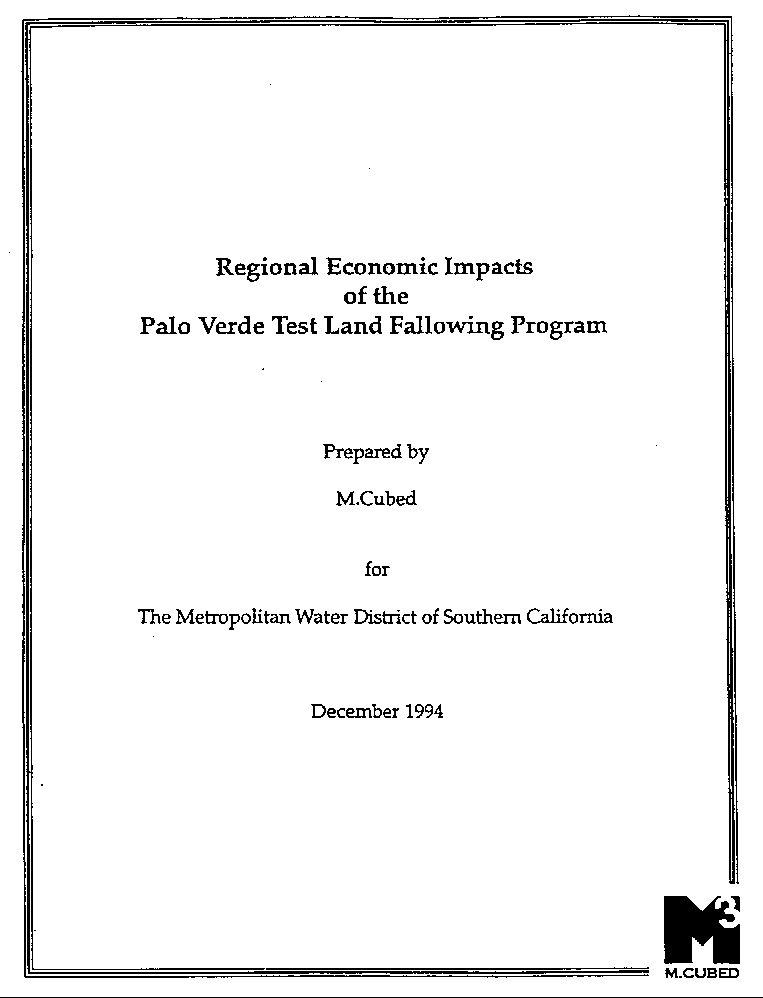
EXECUTIVE SUMMARY
On August 1, 1992, the Metropolitan Water District of Southern California (Metropolitan)
initiated the Test Land Fallowing Program (Program) with farmers within the Palo Verde
Irrigation District (PVID). The two-year agreement worked as follows: Program participants
could enroll up to 25% of their productive acreage in the Program in exchange for a per enrolled
acre payment of $1,240; enrolled acreage was then left fallow and not irrigated for two years;
water savings were calculated and credited to Metropolitan. In total, 20,215 acres-roughly 22%
of the valley's cultivated acreage-were enrolled in the Program. Program payments totaled
approximately $25.1 million.
Program participants were surveyed at the end of the first and second years of the Program
to evaluate farm level adjustments and costs associated with Program participation. The results
of these surveys are reported in Great Western Research (1993; forthcoming).
The purpose of this study is to evaluate the economic impacts to Program non-participants
such as local businesses providing farm services or supplies, as well as the Program's overall
impact on the regional economy. Reported findings are based on telephone and field interviews
and survey of local retail and wholesale businesses and community officials; crop budget
analyses of changes in input purchase patterns; and analyses of regional quarterly sales tax and
monthly employment data.
The principal findings of this study are as follows:
- The Program was not found to have affected overall regional economic performance to any
significant degree. City officials and local bank representatives characterized the current state of
the region's economy as improved relative to prior to the Program. The Program was not found to
have affected the region's property or sales tax bases, or the provision of government services. It
was, however, found to have contributed to a modest loss of employment in the region. Over the
two-year period, the Program was found to have contributed to the loss of 27 full-time farm jobs,
25 full-time jobs in farm-related businesses, and seven part-time/seasonal jobs in farm-related
businesses. The combined losses were equal to approximately 1.3% of the region's average
employment for 1991-92.
- The Program was not found to have caused non-farm-related businesses in the region to
reduce employment or lose revenue. Surveyed and interviewed non-farm-related businesses
indicated that the Program had no perceptible effect on their revenues, and did not cause them
to adjust their employment. In addition, businesses surveyed whose farm-related sales in the
region comprised less than 20% of their total revenue also indicated that the Program did not
affect their businesses in any significant way.
- Negative economic impacts of the Program concentrated within farm-related businesses
providing services or supplies to the region's farmers. Three-fourths of surveyed businesses
providing farm services characterized the Program as causing a significant decrease in revenues
in 1993, while three of four respondents providing farm supplies characterized it as causing a
minor decrease. It should be noted, however, that approximately 70% of all firms surveyed
characterized the Program as causing only a minor decrease or having no impact on their
revenues during the first year, while approximately 77% characterized it as causing a minor
decrease, no impact, or a minor increase in their revenues during the second year.
Employment losses caused by the Program also were found to have concentrated within
farm-related businesses. Overall, four of five surveyed firms providing farm services or
supplies characterized the Program as a primary, though not necessarily the only, reason for
reducing employment between 1992 and 1994. These firms reduced full-time employment by a
total of 25 jobs and part-time/seasonal employment by seven jobs over the two-year period.
While the Program did not negatively affect the overall performance of the local economy, it
did result in concentrated impacts on a few businesses providing farm services and, to a lesser
extent, farm supplies.
- The Program was found to be only one of several causes for a reduced regional demand for
farm-related labor, services, and manufactured inputs. It is important to emphasize that there
were many factors simultaneously affecting the local demand for farm services and supplies. For
example, since 1988, the region's lettuce acreage has decreased by approximately 15,000 acres
due to whitefly infestation and other factors unrelated to the Program. It is estimated that this
reduction has caused the annual demand for seed, fertilizer, chemicals, and custom services to fall
by approximately $8.3 million, and the annual demand for custom harvest services by
approximately $19 million. By comparison, it is estimated that the Program reduced the annual
demand for seed, fertilizer, chemicals, and custom services by approximately $4.0 million while
it was in effect. While the Program did produce a measurable decrease in farm-related activity, it
should be noted that the significant decrease in vegetable and melon production in the region due
to whitefly and other factors not related to the Program has had a more pronounced and lasting
effect on the demand for farm labor, services, and supplies.
- A high proportion of Program payments were injected into the local economy. Program
participants reportedly spent 93% of Program payments in excess of fallowing and maintenance
costs on farm-related investments, purchases, and debt repayment. Approximately 61% of
Program payments in excess of costs was spent within the local economy. The Program was
found to have provided timely financial relief to the region's agricultural producers who had been
under significant hardship due to low prices for key commodities, especially alfalfa, and pest
infestation.
Overall, the analysis indicates that the Program contributed to a modest decrease in regional
employment-approximately 1.3% of average employment for 1991-92 but did not result in
measurable changes in other regional economic performance indicators such as taxable sales,
property tax revenues, and construction activity. It also should be noted that while approximately
61% of Program payments were reportedly spent locally, it was beyond the scope of this study to
attempt to measure possible job gains or increased economic activity associated with this
spending.




